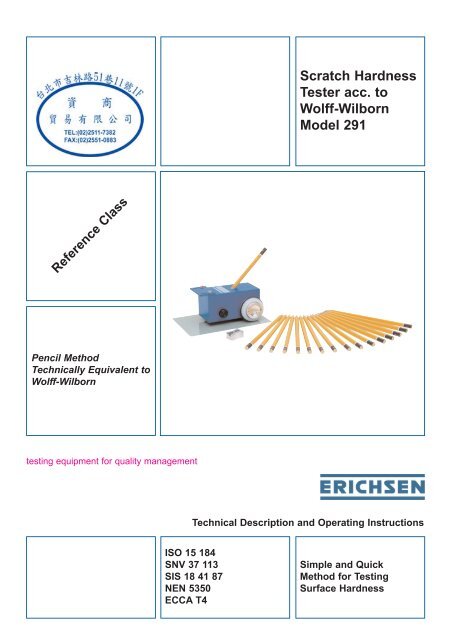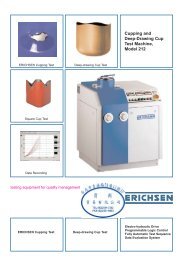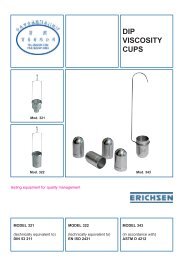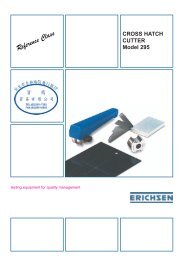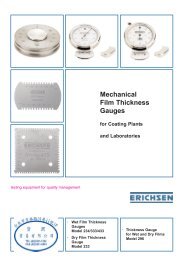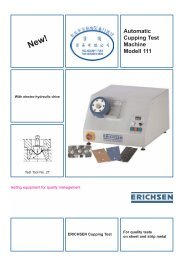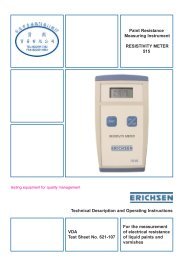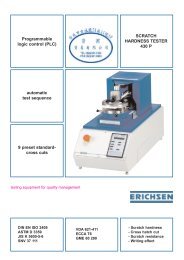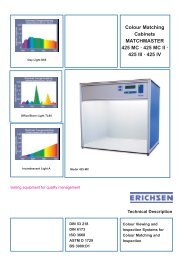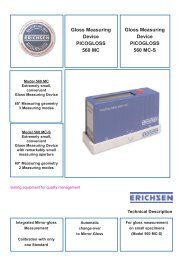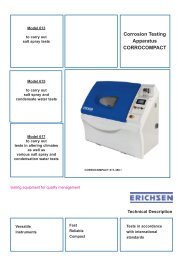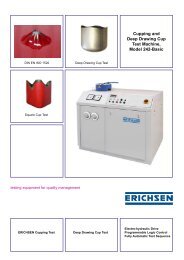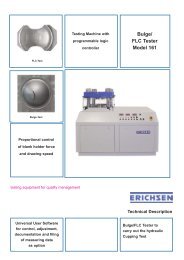Scratch Hardness Tester acc. to Wolff-Wilborn Model 291
Scratch Hardness Tester acc. to Wolff-Wilborn Model 291
Scratch Hardness Tester acc. to Wolff-Wilborn Model 291
You also want an ePaper? Increase the reach of your titles
YUMPU automatically turns print PDFs into web optimized ePapers that Google loves.
<strong>Scratch</strong> <strong>Hardness</strong><br />
<strong>Tester</strong> <strong>acc</strong>. <strong>to</strong><br />
<strong>Wolff</strong>-<strong>Wilborn</strong><br />
<strong>Model</strong> <strong>291</strong><br />
Reference Class<br />
Pencil Method<br />
Technically Equivalent <strong>to</strong><br />
<strong>Wolff</strong>-<strong>Wilborn</strong><br />
testing equipment for quality management<br />
Technical Description and Operating Instructions<br />
ISO 15 184<br />
SNV 37 113<br />
SIS 18 41 87<br />
NEN 5350<br />
ECCA T4<br />
Simple and Quick<br />
Method for Testing<br />
Surface <strong>Hardness</strong>
Purpose and Application<br />
The pencil method belongs <strong>to</strong> the group of<br />
scratch hardness testing instruments. This is a<br />
simple and quick method for testing the surface<br />
hardness of coatings with regard <strong>to</strong> stresses<br />
inflicted by scratching with sharp edges, or other<br />
rough surfaces. It can also be applied during<br />
production, e. g. for coil coatings.<br />
Test Principle<br />
Pencils of various grades of hardness are<br />
moved over the painted surface at an angle of<br />
45° <strong>to</strong> the horizontal with a force of 7.5 ± 0.1 N.<br />
The pencil hardness is defined by those two<br />
grades of hardness the softer one of which just<br />
produces a writing trace while the next harder<br />
one leaves a perceptible scratch on the coating.<br />
Design and Function<br />
The <strong>Scratch</strong> <strong>Hardness</strong> <strong>Tester</strong>, <strong>Model</strong> <strong>291</strong>,<br />
enables the test <strong>to</strong> be carried out technically<br />
equivalent <strong>to</strong> <strong>Wolff</strong>-<strong>Wilborn</strong> and ensures that the<br />
specified force and angle remain constant<br />
throughout the test. Guidance of the instrument<br />
is easy and excludes manual influences of the<br />
pencil pressure.<br />
An assortiment of pencils with 17 degrees of<br />
hardness from 6 B <strong>to</strong> 9 H serve for the test.<br />
Test Procedure<br />
The pencil points are sharpened so that the<br />
graphite point protrudes about 5 mm. For this<br />
purpose use the special sharpener which is<br />
included in the scope of supply. The graphite<br />
point is face-ground sharp-edged on emery<br />
paper with a grain size of 400 for which the<br />
pencil is held vertically.<br />
The pencil is clamped in<strong>to</strong> the holder block so<br />
that the pencil point protrudes about 5 mm. The<br />
instrument is now placed on the test specimen.<br />
The hubs of the wheels are held with the thumb<br />
and forefinger and the instrument is moved<br />
over the specimen in the direction the pencil<br />
point shows at a speed of about 10 cm/s.<br />
The appropriate pencil hardness has <strong>to</strong> be<br />
established empirically. It is recommended <strong>to</strong><br />
start testing with a medium soft pencil or<br />
medium hard one and <strong>to</strong> narrow down <strong>to</strong> the<br />
most suitable pencil type.<br />
During the test it is necessary <strong>to</strong> be careful not<br />
<strong>to</strong> mix up the writing of the pencil with<br />
penetration in<strong>to</strong> the film. Should it be necessary,<br />
a moist sponge or a soft pencil eraser can be<br />
used <strong>to</strong> remove excess marking.<br />
The numbers of the two pencil types defined are<br />
indicated as pencil hardness. A pencil hardness<br />
of 2 H...3 H for example means that pencil type<br />
2 H still writes on the surface while pencil type 3<br />
H already slightly scratches the film.<br />
Highly pigmented paint or that containing flakeshaped<br />
pigments are not recommended for use<br />
with this test method.<br />
Order No.<br />
0038.01.31<br />
Order No.<br />
Order Information<br />
Description<br />
<strong>Scratch</strong> <strong>Hardness</strong> <strong>Tester</strong><br />
<strong>acc</strong>. <strong>to</strong> <strong>Wolff</strong>-<strong>Wilborn</strong>,<br />
<strong>Model</strong> <strong>291</strong><br />
incl. 17 standardised pencils<br />
1 special sharpener,<br />
1 sheet of emery paper<br />
Spare Parts<br />
Description<br />
91 0919141 1 Set of standardised pencils<br />
(17 off)<br />
89 0114 Special sharpener<br />
82 0113541 Abrasive paper, grain size 400<br />
The right of technical modifications is reserved.<br />
Group 14 - TBE + BAE <strong>291</strong> - IX-99


